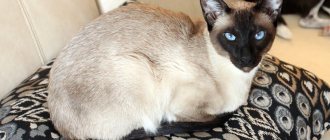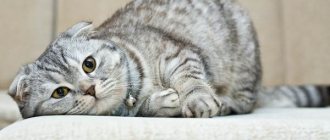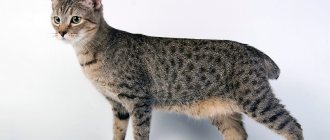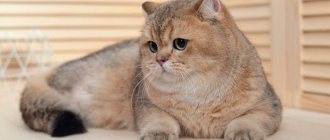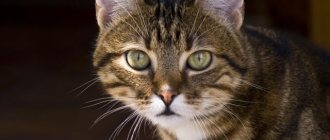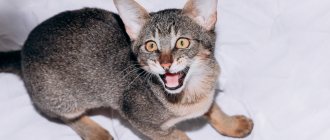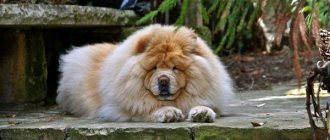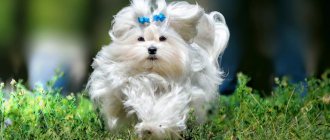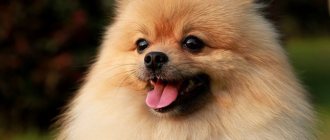History of the origin of the domestic Bengal breed
global $ads_google;
//data-ad-slot=”2475549904″ $ads_google = empty($ads_google) ? false : true; ?> if ($ads_google == false) {?> $ads_google = true; ?> } ?> The goal of breeding the Bengal cat, the founder of the breed, American Jane Mill, considered obtaining a domestic cat that preserved the color of its wild ancestors - this would help focus attention on the serious problem of extermination of leopard cats.
The history of the origin of the Bengal breed began almost 60 years ago, in 1961, when Jane came to Bangkok. This trip became fateful: there she received a baby Asian leopard cat, which is almost impossible to tame. The purchased baby received the name Malaysia and settled down with the new owner. The grown cat gave birth to offspring from a domestic shorthair cat, but the vicissitudes of fate did not allow her to start breeding a new breed.
A new attempt was made by Jane in 1980. She was provided with 9 hybrids of a leopard cat and domestic cats of different breeds. Then Mill fell into the hands of an Indian cat with a golden-orange color, which gave the Bengals a shiny coat called glitter.
The work was long and difficult due to many factors, and ended in success and recognition by the early 90s.
Reproduction and lifespan
There is currently no information on how oncillas reproduce. They are monitored only in inanimate nature. A cat gives birth to no more than two kittens at a time. She carries them for almost three months. In the wild, oncilla can live no more than 15 years. In captivity, its life expectancy is 20 years.
In the photo there is a tiger kitten
Description and standards of Bengal cats
It is impossible not to notice the external features of an exotic cat. Even when very small, the baby Bengal looks like a leopard. An adult Bengal cat receives the highest reviews and, just from one verbal description, is a true beauty.
According to the WCF standard, the breed must have a number of characteristics.
The head is a wedge with a massive chin and thickened chin pads. Thanks to this structural feature, the animal’s muzzle resembles a tiger’s mouth. This similarity is even more noticeable during yawning, meowing or growling.
The ears are short and set high on the head. They are wide at the base and their tips are rounded.
The nose is large, curved and moderately wide.
The eyes are almond-shaped and very beautiful. Eye color is clear green or golden.
The head is located on a thick and strong neck, which is in ideal proportions in relation to both the head and the body.
A cat of this breed has a large body and strong muscles.
Bengals run around the house on round, large and powerful paws. As usual, the length of the hind legs exceeds the length of the front ones.
The tail is medium in size, does not fluff, and is dense to the touch. The domestic leopard's tail has spots or rings.
Bengals are short-haired creatures with a soft, silky coat.
When interested in a description of a particular cat breed, people who are allergic to the Fel D1 protein first of all find out whether this charming creature is a hypoallergenic animal. Despite the fact that shedding almost does not affect these cats, they themselves carry the entire allergen on their skin.
global $ads_google; //data-ad-slot=”2475549904″ $ads_google = empty($ads_google) ? false : true; ?> if ($ads_google == false) {?> $ads_google = true; ?> } ?>
The breed presents a wealth of colors. A popular color is spotted-striped. This variety has shades of gray, white or red.
The most common and characteristic color of the Leopardette breed makes the cat look like a leopard.
“Sorrel” in cats finishes forming closer to the year. The coat is golden, the spots are chocolate brown, and the tip of the tail is black.
A sign of the marbled variety is spots of a peculiar, non-leopard shape.
Cats in white and gray colors are called "snow leopards". Kittens are born white, only later acquiring their characteristic color.
The colors of the Bengal breed also be called: rosette on gold, rosette on silver, marble on gold, marble on silver, seal links point, seal mink, seal sepia, charcoal, blue.
Glitter and phasing in Bengal kittens
Fazing in Bengal kittens is the process when babies from one month to four months are covered with gray or dull white fur. The name of the process comes from the English word fuzzy - unclear, uncertain. When the baby is more than a month old, the owner suddenly notices that the appearance of the young Bengal is changing. His fur becomes strewn with protruding whitish hairs, and the cat looks shaded. If phasing is severe, it makes it very difficult to see the pattern and color of the skin. The full beauty of the fur coat returns to eight months of the animal’s life.
Phasing does not manifest itself in every Bengal kitten.
The breed is characterized by glitter - a particularly strong shine to the coat. This is not a mandatory parameter for exhibitions; you can purchase a cat with or without glitter, since the standard allows both types for all representatives of the breed.
Dimensions and weight of Bengals
When buying such a pet for a home, the owner should imagine how big a Bengal cat grows. The height of an adult animal at the withers is 40-41 cm. The animal grows to this established norm by 1.5 years, but the complete completion of growth processes is completed by the age of two years.
The typical weight of purebred cats is 3.5-5.5 kg. An adult male is more massive than a female and weighs 5-8 kg. Animals of both sexes are larger and smaller than the declared weight, but this does not happen often.
If a cat seems very large and its weight is quite high, this does not mean that obesity has appeared: Bengals are nimble and energetic creatures, and, most likely, their body weight is due to the pet’s excellent physical shape and well-developed muscles.
The body length of an adult handsome leopard is about 90 cm, and the height at the withers is 40-41 cm.
global $ads_google;
//data-ad-slot=”2475549904″ $ads_google = empty($ads_google) ? false : true; ?> if ($ads_google == false) {?> $ads_google = true; ?> } ?> Table of weight of Bengal cats by month
| Age | Female | Male |
| newborn | 65-110 gr | 70-125 gr |
| 1 month | 350-500 gr | 390-560 gr |
| 2 months | 640-1100 gr | 750-1300 gr |
| 3 months | 1.2-1.6 kg | 1.3-2.2 kg |
| 4 months | 1.7-2.6 kg | 2.5-3 kg |
| 5 months | 2.5-3.1 kg | 2.8-4 kg |
| 6 months | 2.8-3.9 kg | 3.1-4.3 kg |
| 8 months | 3.2-4.8 kg | 3.7-5.1 kg |
| 10 months | 3.3-5 kg | 4.3-5.6 kg |
| 1 year | 3.4-5.2 kg | 4.8-6.3 kg |
| 2 years | 3.5-5.5kg | 5-8 kg |
Breeds of cats with brindle color
In fact, brindle stripes (brindle tabby) are present in almost all cats; they are only noticeable to the human eye in a few breeds. The tiger cat of the Toyger breed is one of the youngest.
The photo shows a tiger cat of the Toyger breed.
Translated from English, toyger is a toy tiger. The Toyger is one of the most exotic and expensive breeds in the world. Her brindle coloring is certainly a delight. Such a cat gives a special chic to the house where she lives and is a sign of the wealth of its owners.
Some call them tigers, which is incorrect and distorts the meaning of the word. A Toyger is nothing more than a cross between a regular cat and a Bengal cat.
However, in appearance it looks like a real tiger, only several times reduced in size. The graceful, aristocratic appearance of brindle cats finally took shape in 2007, after a long search for ideal parents.
If you look at photos of brindle cats , you will notice that they have a rather curious body structure. They are large, weighing up to 6–8 kg, with a long thin tail and small paws.
Their muzzle is elongated and has a wide nose that is unusual for cats. Also, toygers have a powerful neck, with standard ears and large blue eyes. Although selectors at this stage of time are working on making the eyes smaller and the ears smaller. They want to give the ears a more rounded shape.
The tiger cat in the photo looks exactly the same as in life. Its color really exactly matches that of a tiger. Tiger stripes come in both black and brown, and even auburn. The coat is short and smooth. Its paws and the tip of its tail are black, and in addition to the stripes, there are spots and rosettes on the body and muzzle.
The domestic toyger is unusually calm and affectionate. He doesn't need much attention. In addition to the usual language for cats, toygers make other sounds similar to those of birds. Kittens are playful and active, like other breeds. Adult cats are loyal and intelligent.
The American Shorthair cat has been known since the beginning of the 20th century. She is quite peaceful and is a real long-liver among cats. Its lifespan can reach 20 years. Her tiger stripes come in a variety of colors.
The short-legged munchkin is one of the most mischievous breeds among brindle cats. Its fur is short and thick, and can be of absolutely any color, but with a tiger pattern. The breed appeared in 1991 and is distinguished by very short legs. These cats are more like dachshunds.
In the photo there is a munchkin cat of brindle color
The Siberian cat also became popular at the end of the last century. She is in no way inferior in devotion to dogs. Its fur is medium length and its weight can reach 12 kg.
The British tiger cat is known for its special character. If you don't raise her as a child, she will only do what she wants. She needs a lot of personal space and a place to retire. Its coat is quite short and its brindle coloration comes in different variations. The British are a bit like the Cheshire Cat from a fairy tale.
In the photo there is a kitten of the British brindle breed
The Scottish tiger cat has a marble tabby color on the back and dense wide stripes on the tail. On their head they have a characteristic marking in the form of the letter “M” in the same color as the pattern on their body. Their eyes are large and yellow, and their ears are smaller than other breeds.
The photo shows a Scottish tiger cat kitten
Characteristics of Bengal cats
The appearance of a Bengal kitten in the house expands the horizons of its owners and narrows their horizons to raising one nimble little rascal. The cat's character is bright and memorable: the combination of the natural intelligence of a predator merges with the soft playfulness and sociability of its domestic ancestors.
Reviews about domestic leopards are similar in that these cats are extremely intelligent creatures, so raising and training them is a pleasure. The family favorite remembers commands easily. It doesn't take long to train your Bengal to use the litter box.
The cat’s adaptation to new conditions occurs quickly; very soon the baby will explore all available places and begin to explore forbidden areas. You can compare the character of a Bengal with the character of dogs - he is just as ready to defend his territory, protect his owner, and carry objects from place to place. During the game, the Bengal pet will easily return the abandoned toy, since he himself is interested in spending time with the owner or his child in this way, which is why it is recommended to train the cat.
global $ads_google; //data-ad-slot=”2475549904″ $ads_google = empty($ads_google) ? false : true; ?> if ($ads_google == false) {?> $ads_google = true; ?> } ?>
Cats welcome the company of their beloved household members and are very talkative, but you should not cuddle the animals. Cats are also good with other domestic animals and can make friends with dogs. Bengal girls are well socialized, but they do not approve of communicating with strangers - they need time to understand whether a person entered the house with good intentions.
The animal picks up the mood of its owners very accurately, reacts sensitively to changes in tone of voice, and remembers the words addressed to them.
Raising a cat should start as early as possible. Bengalis are very socialized, they learn understanding and learn about the world from a person's voice. In addition, these cats, like dogs, remember words and are able to follow commands.
They regularly devote time to raising the spotted cat, mainly by playing with the young predator. The game allows the Bengal pussy to show the predatory instincts of a hunter and learn an acceptable behavioral model. Aggressive actions of a cat must be stopped, so it is important to know how to properly raise a cat.
Bengal cats definitely need physical exercise: cats' access to heights is encouraged.
Care and feeding of Bengals
A short-haired cat brings less worries at home than its long-haired counterparts, which makes caring for your pet much easier. Keeping and caring for a cat is not difficult: 2-3 times a week, devote a little time to combing the fur, which a soft rubber brush will help with. Sometimes you may not even notice the shedding, but once the procedure has begun, it is better to comb the kitty more often.
The descendant of a wild leopard cat needs to trim its claws once every couple of weeks. The ears are cleaned at the same intervals with a damp cotton pad.
It is also necessary to take care of your pet's oral cavity by brushing its teeth once a week.
The bath easily becomes a favorite place for the Bengal, who happily hits the water with his paws. Washing is allowed in rare cases using special cat shampoos.
Feeding a Bengal kitten occurs from month to month according to the feeding schedule and recommendations of specialists. Good nutrition quickly turns a small cat into a healthy, strong cat.
What to feed a Bengal kitten for 2 months
They also feed raw meat (beef or rabbit), exclude raw offal from the diet, replacing them with boiled sea fish once a week. Dairy products in the form of kefir, baby cottage cheese without any additives, and low-fat cream are useful for cats. The daily food intake also involves the addition of vegetables not exceeding a quarter of the volume of meat products. These are carrots, tomatoes, bell peppers. A Bengal cat can be switched to premium and super premium dry food, which the animals eat with benefit and pleasure.
Keeping a neutered cat involves replacing natural nutrition with specialized food.
How do you get brindle coat color?
Brindle or tabby mackerel is a subspecies of the tabby color. Cats with this pattern resemble miniature tigers. This color is a variation of the colors of cats found in the wild.
Many domestic cats have a ticking pattern called tabby. Ticking appears as a consequence of the dominance of the agouti gene. Each hair has light and dark stripes. Full pigmentation of hair that is in the growth phase is also possible. Then pigment synthesis slows down and resumes after some time. When the hair reaches its full length, pigment synthesis is complete. As a result, the hairs have dark pigmentation at the tips, then there is a yellow or orange stripe, followed by a dark area, and again yellow or orange. It turns out to be a kind of “striped flight”.
Interestingly, genetically the brown tabby is a black color, but as a result of selecting individuals with a pronounced red color, it was possible to obtain a dense brown tone in the ticked hairs.
The tabby color is determined by the gene (T), which causes the appearance of spots and stripes of the main tone on the ticked coat.
Commonly known tabby types:
- Tiger tabby - striped hairs are located on the main background (like a tiger).
- Classic tabby - ticked hairs appear in patches on the sides or back.
- Ticked Tabby (Agouti or Abyssinian) - The ticked hairs are evenly spaced and give the coat a freckled appearance.
- Spotted Tabby - The main background has ticked hair, spots or rosettes (like a leopard or jaguar).
The spotted tabby is not classified as a separate genotype. Scientists have not yet figured out the nature of the origin of the spotted tabby. Whether it can be considered a mutation of the tabby gene or is it just a polygenetic modification of the brindle tabby is not yet clear. Spotted tabby is observed in different species of wild cats and indicates an independent gene mutation. However, in practice, the spotted tabby produces offspring with spotted and striped patterns, so breeders always choose sires with clear spots, otherwise the pattern tends to shift to brindle.
Tortoiseshell cats also have a tabby pattern. In a tortoiseshell tabby, the pattern appears in the black and red areas. Solid and ticked stripes on a red background fade smoothly into black areas.
Health of the Bengal cat breed
Fortunately, thanks to breeding work and natural hereditary immunity, Bengal exotic beauties have excellent health indicators. But if their immunity resists most feline diseases, then there are some genetic diseases, the fight against which in many cases is quite successful.
global $ads_google; //data-ad-slot=”2475549904″ $ads_google = empty($ads_google) ? false : true; ?> if ($ads_google == false) {?> $ads_google = true; ?> } ?>
The most common phenomenon is “dry nose syndrome.” This problem can occur in kittens up to one year of age. You can't miss a dry nose: cracks and crusts on the surface of the nose become ulcers. In general, this condition is not critical to health and does not cause any special problems for the animal itself. To know for sure whether a dry nose promises trouble, it is better to consult a veterinarian - it happens that this condition develops into an ulcerative lesion of the nose. The doctor prescribes timely treatment that will help restore the healthy state of the nasal surface.
Bengals are sensitive to poor quality food, so to avoid loose stools, the cat is fed only selected food and always provides the pet with fresh water.
There are two serious genetic disorders: hypertrophic cardiomyopathy (HCM) and flat chest syndrome (FCK) in kittens. In the first case, observations and testing are mandatory; proper care will allow the cat to live a long and good life. The second problem is a serious obstacle to the survival of kittens and is looking for a solution. If a Bengal cat was taken from a cattery with a good reputation, where inbreeding and the use of antibiotics by the pregnant female were not allowed, the problem is unlikely to affect her and her offspring.
Miniature leopards are vaccinated according to a schedule starting at 8 weeks. All vaccinations are prescribed by a veterinarian.
The life expectancy of a healthy Bengal cat is 14-16 years if it lives under the supervision of attentive and caring owners.
If the cat was taken as a family pet, then you need to monitor the onset of puberty in order to castrate or sterilize the animal in time. The first heat in a Bengal cat occurs at 6-8 months, when the female’s weight reaches 2.5-3.3 kg. Cats “grow up” by 9 months. If you want to get offspring from your pet, you need the obligatory assistance of a specialist in breeding, otherwise even a successful mating, healthy pregnancy and problem-free childbirth do not guarantee full-fledged offspring.
Buy a Bengal kitten
Nurseries where you can buy a Bengal kitten are quite common in Russia. You won’t be able to save money on buying a descendant of a wild Asian leopard cat if you want to buy a purebred animal that will strictly meet the standards. In the nursery, the buyer will learn all the information about the future cat, its pedigree, and hear interesting facts about the character of the domestic mini-leopard.
The cost of the Bengal remains high precisely because of the difficulties with breeding. The first generation of Bengals will be infertile if they are males. Females of the first generation are crossed with Bengals and a second generation is obtained, where most of the males are sterile. In the third generation from the f2 female, only some males are sterile. The fourth generation are considered true representatives of the Bengal breed, and have a full range of characteristic skills and traits.
The price for a Bengal cat in Russia is:
- pet class
25,000-50,000 rubles; - breed class
50,000-100,000 rubles; - show class from
100,000 rubles
.
What to name a Bengal kitten
When a Bengali boy or girl arrives in the house, the family may have a number of names ready. But before you give the kitten a nickname, you should know that it must begin with the same letter as the name in the passport.
global $ads_google; //data-ad-slot=”2475549904″ $ads_google = empty($ads_google) ? false : true; ?> if ($ads_google == false) {?> $ads_google = true; ?> } ?>
Also, you should not give a new cat the nickname of your previous pet, this is not only a bad omen, but also a careless attitude towards the memory of a deceased or missing pet.
A long name is difficult to pronounce and difficult for a cat to remember. Hissing sounds are welcome, to which the cat will react most quickly. You can experiment and try calling the cat by different names. There is a chance that the animal will choose its own name.
Handy tables have been created with names that might be suitable.
| Girl | Boy | ||
| Julie Dosya Cleo Dotty Shelma Ivy Eva Aida Stesha Fanta Vikki Iksa Yesya Lika Liya | Almira Brandy Toffee Yuni Tori Lynx Klepa Cher Goldie Ulfi Bara Baksa Goldie Lucky Finka | Joshua Joe Alistair Leo Easy Bingo Ike Luntik Wirt Tory Rain Ride Whiskey Martin Ralph | Vince Rick Jacques Mort Indie Byte Drake Knight Spot Fima Gore Chen Zipper Gizmo Weiss |
Description and features of the wild tiger cat
Oncilla is a tiger cat that lives in the wild. It is much larger than a domestic cat, but the smallest among other wild cats. Oncillas most often have yellow-gray fur with tiger stripes. These cats are not afraid of water and swim well, although not so often.
The wild tiger cat (oncilla) resembles a miniature jaguar. Its coat is short and has characteristic stripes. These stripes on the body consist of individual spots closed in rings.
They clearly go in rows and do not break into separate spots. The stripes on the tail at first simply follow lines of spots, and then these lines connect to the end of the tail, forming rings.
Pictured is a tiger cat Oncilla
Oncilla has several subspecies that differ slightly in color. It is quite rare, although it lives in many places. In the last century, it was hunted for its valuable fur. Its population decreases every year due to deforestation.
The Australian tiger cat is quite unpretentious. It feeds on various small animals and sometimes attacks domestic chickens. In her pouch she carries newborn cubs, of which there can be more than ten.
Conclusions about the breed
The Bengal cat deservedly receives praise and admiration, but not only due to its chic external characteristics:
- The cat's character is ideal for sociable and sensitive people. Both adults and children can play with the furry baby;
- if the owner does not have time to care for the cat, then it is better to opt for a less demanding breed;
- without experience it is not worth breeding cats;
- a well-developed intellect only pleases;
- the cat does not like to be squeezed;
In general, Bengals have good health and delight with their intelligence.
Conditions for keeping
Keeping brindle cats is not burdensome. Short-haired animals are combed once a week with a rubber mitten. Scottish and British cats have a thick undercoat that actively sheds twice a year, so the animals need to be brushed more often. A furminator can handle this task. The same rule applies to Siberian cats. Their luxurious fluffy coat sheds profusely in the spring and during the heating season. Tools such as a slicker and the same furminator will come to the rescue.
Breeders recommend giving the cat its own corner in the house, placing a house or bed there, as well as a scratching post. In addition, animals are given a place to litter and eat.
Bath days are organized twice a year. However, you should also remember that most cats are not happy about bathing. For example, the Scots and British are afraid of water like fire, but toygers and begals, on the contrary, love to swim. Therefore, it is important to take into account the characteristics of each breed and not force your pet.
The diet is selected depending on the breed, taking into account the recommendations of veterinarians.
Toygers inherited good health from their ancestors and experts do not give any special recommendations on nutrition.
Bengals should be fed natural high-protein foods or premium dry and wet food.
Tender Sokoke require a balanced diet fortified with taurine and vitamin E due to heart problems and metabolic disorders.
Mau are prone to allergies, asthma and heart disease, so they need special fortified food. Pet stores have lines of dry and wet food with a balanced composition that can maintain animal health.
It is recommended to feed Savannah with natural products: beef, poultry, ocean white fish, and give dry food as an addition to the main diet.
American Shorthairs, Scottish Shorthairs and British Shorthairs love to eat and are prone to weight gain. Therefore, animals need to be fed twice a day, and periodically pampered with boiled chicken breast.
Siberian cats need a balanced diet. For 1 kg of weight they give 30-60 g of feed. To maintain the beauty of their coat, cats under 3 years of age are given food containing 70% protein.
